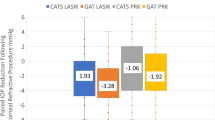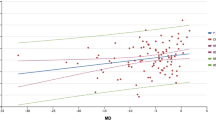Abstract
Purpose
Corneal hysteresis (CH) is a corneal biomechanical property measured by the ocular response analyzer (ORA). It is associated with primary open-angle glaucoma development, progression, and severity as well as intraocular pressure (IOP) measurement. Decreases in CH and changes in IOP measurements have been described for laser-assisted refractive surgery; however, patients with prior radial keratotomy (RK) have not been examined. We have performed a cohort study examining CH and intraocular pressure measurements (Goldmann applanation and ORA values including Goldmann-correlated and cornea-compensated IOP [adjusted for corneal hysteresis]) in RK patients and myopic controls with POAG.
Methods
Eighty POAG patients (28 RK and 52 myopic controls) were recruited. Central corneal thickness (CCT), prostaglandin analogue (PGA) use, perimetric stage, and history of cataract and glaucoma filtration surgery were assessed through chart review. Participants underwent testing with the ORA (yielding measures of CH, cornea-compensated [IOPcc], Goldmann-correlated IOP [IOPgc], and corneal resistance factor [CRF]), Goldmann applanation, A-scan for axial length (AL), and corneal topography. Slit lamp exam was performed to assess for number of incisions in RK patients.
Results
Adjusting for AL and CCT, CH was significantly lower in the RK group with an estimated difference of 0.8585 mmHg (p = 0.0112). Cornea-compensated intraocular pressure was significantly higher in the RK group after controlling for Goldmann applanation, AL, and CCT (2.35 mmHg difference, p < 0.001). Corneal resistance factor and IOPgc were not significantly different. A correlational analysis did not reveal a significant correlation between numbers of RK incisions and CH.
Conclusions
We report significant differences, with lower CH and higher IOPcc, when comparing eyes with glaucoma and either a history of RK or myopia. These findings may aid in establishing normative decreases in CH with RK and POAG and indicate a possible under-estimation of pressure in RK patients.
Similar content being viewed by others
References
Bochmann F, Ang GS, Azuara-Blanco A (2008) Lower corneal hysteresis in glaucoma patients with acquired pit of the optic nerve (APON). Graefes Arch Clin Exp Ophthalmol 246(5):735–738
Wells AP, Garway-Heath DF, Poostchi A et al (2008) Corneal hysteresis but not corneal thickness correlates with optic nerve surface compliance in glaucoma patients. Invest Ophthalmol Vis Sci 49(8):3262–3268
Prata TS, Lima VC, Guedes LM et al (2012) Association between corneal biomechanical properties and optic nerve head morphology in newly diagnosed glaucoma patients. Clin Exp Ophthalmol 40(7):682–688
Chang PY, Chang SW (2013) Corneal biomechanics, optic disc morphology, and macular ganglion cell complex in myopia. J Glaucoma 22(5):358–362
Congdon NG, Broman AT, Bandeen-Roche K et al (2006) Central corneal thickness and corneal hysteresis associated with glaucoma progression. Am J Ophthalmol 141(5):868–875
Abitbol O, Bouden J, Doan S et al (2010) Corneal hysteresis measured with the ocular response analyzer in normal and glaucomatous eyes. Acta Ophthalmol 88(1):116–119
Mansouri K, Leite MT, Weinreb RN et al (2013) Association between corneal biomechanical properties and glaucoma severity. Am J Ophthalmol 153(3):1–18
DeMoraes CV, Hill V, Tello C et al (2012) Lower corneal hysteresis is associated with more rapid glaucomatous field progression. J Glaucoma 21(4):209–213
Medeiros F, Meira-Freitas D, Lisboa R et al (2013) Corneal hysteresis as a risk factor for glaucoma progression: a prospective longitudinal study. Ophthalmology 120(8):1533–1540
Mangouritsas G, Mourtzoukos S, Mantzounis A et al (2011) Comparison of goldmann and pascal tonometry in relation to corneal hysteresis and central corneal thickness in non-glaucomatous eyes. Clin Ophthalmol 5:1071–1077
Wang J, Cayer MM, Descovich D et al (2011) Assessment of factors affecting the difference in intraocular pressure measurements bewteen dynamic contour tonometry and goldmann applanation tonometry. J Glaucoma 20(8):482–487
Costin BR, Fleming GP, Weber PA et al (2014) Corneal biomechanical properties affect goldmann applanation tonometry in primary open angle glaucoma. J Glaucoma 23(2):69–74
Samuelson TW (2014) Refractive surgery in glaucoma. Curr Opin Ophthalmol 15(2):112–118
Shrivastava A, Madu A, Schultz J (2011) Refractive surgery and the glaucoma patient. Curr Opin Ophthalmol 22(4):215–221
Pepose JS, Feigenbaum SK, Qazi MA et al (2007) Changes in corneal biomechanics and intraocular pressure following LASIK using static, dynamic, and non-contact tonometry. Am J Ophthalmol 143(1):39–47
Ortiz D, Pinero D, Shabayek MH et al (2007) Corneal biomechanical properties in normal, post-laser in situ keratomileusis, and keratoconic eyes. J Cataract Refract Surg 33(8):1371–1375
Chen MC, Lee N, Bourla N et al (2008) Corneal biomechanical measurements before and after laser in situ keratomileusis. J Cataract Refract Surg 34(11):1886–1891
Kirwan C, O'Keefe M (2008) Corneal hysteresis using the Reichert ocular response analyser: findings pre-and post-LASIK and LASEK. Acta Ophthalmol 86(2):215–218
Kamiya K, Shimizu K, Ohmoto F (2009) Comparison of the changes in corneal biomechanical properties after photorefractive keratectomy and laser in situ keratomileusis. Cornea 28(7):765–769
Qazi MA, Sanderson JP, Mahmoud AM et al (2009) Post-operative changes in intraocular pressure and corneal biomechanical metrics, laser in situ keratomileusis versus laser-assisted subepithelial keratectomy J Cataract Refract Surg 35(10):1774–1788
Shah S, Laiquzzaman M, Yeung I et al (2009) The use of ocular response Analyser to determine corneal hysteresis in eyes before and after excimer laser refractive surgery. Cont Lens and Anterior Eye 32(3):123–128
Fan F, Li C, Duan X et al (2011) Intraocular pressure instrument reading comparisons after LASIK. Optom Vis Sci 88(7):850–854
Shin J, Kim TW, Park SJ et al (2012) Changes in biomechanical properties of the cornea and intraocular pressure after myopic laser in situ keratomileysis using a femtosecond laser for flap creation determined using ocular response analyzer and goldmann applanation tonometry. J Glaucoma 24(3):195–201
Pedersen IB, Bak-Nielsem S, Vestergaard AH et al (2014) Corneal biomechanical properties after LASIK, ReLEx flex, and ReLEx smile by Scheimpflug-based dynamic tonometry. Graefes Arch Clin Exp Ophthalmol 252(8):1329–1335
Wang D, Liu M, Chen Y et al (2014) Differences in corneal biomechanical changes after SMILE and LASIK. J Refract Surg 30(10):702–707
Waring G (1992) Development of refractive keratotomy in the Soviet Union, 1960-1990. In: Waring G (ed) Refractive Keratotomy for Myopia and Astigmatism. Mosby, St. Louis, pp 221–236
Waring G (1992) Refractive keratotomy for myopia and astigmatism. Mosby, St. Louis
Leaming DV (1994) Practice styles and preferences of ASCRS members - 1993 survey. J Cataract Refract Surg 20(4):459–467
Scheuele AF, Martin M, Voelcker HE et al (2008) Undetected development of glaucoma after radial keratotomy. J Refract Surg 24(1):51–54
Waring GO, Lynn MJ, McDonnell PJ (1994) Results of the prospective evaluation of radial keratotomy (PERK) study 10 years after surgery. Arch Ophthalmol 112(10):1298–1308
Salamon SA, Hjortdal JO, Ehlers N (2000) Refractive results of radial keratotomy: a ten-year retrospective study. Acta Ophthalmol Scand 78(5):566–568
Song Y, Congdon N, Li L et al (2008) Corneal hysteresis and axial length among Chinese secondary school children: the Xichang pediatric refractive error study (X-PRES) report no 4. Am J Ophthalmol 45(5):819–826
Jiang Z, Shen M, Mao G et al (2011) Association between corneal biomechanical properties and myopia in Chinese subjects. Eye 25(8):1083–1089
Del Buey MA, Lavilla L, Ascaso FJ et al (2014) Assessment of corneal biomechanical properties and intraocular pressure in myopic Spanish healthy population. J Ophthalmol 2014:905129
Meda R, Wang Q, Paoloni D et al (2017) The impact of chronic use prostaglandin analogues on the biomechanical properties of the cornea in patients with primary open-angle glaucoma. Br J Ophthalmol 101(2):120–125
Pakravan M, Afroozifar M, Yazdani S (2014) Corneal biomechanical changes following trabeculectomy, phaco-trabeculectomy, Ahmed glaucoma valve implantation and phacoemulsification. J Ophthalmic Vis Res 9(1):7–13
Touboul D, Roberts C, Kerautret J et al (2008) Correlations between corneal hysteresis, intraocular pressure, and corneal central pachymetry. J Cataract Refract Surg 34(4):616–622
Mangouritsas G, Morphis G, Mourtzoukos S et al (2009) Association between corneal hysteresis and central corneal thickness in glaucomatous and non-glaucomatous eyes. Acta Ophthalmol 87(8):901–905
Goldich Y, Barkana Y, Gerber Y et al (2009) Effects of diabetes mellitus on biomechanical parameters of the cornea. J Cataract Refract Surg 35(4):715–719
Castro DP, Prata TS, Lima VC et al (2010) Corneal viscoelasticity differences between diabetic and nondiabetic glaucomatous patients. J Glaucoma 19(5):341–343
Gatinel D, Chaabouni S, Adam PA et al (2007) Corneal hysteresis, resistance factor, topography, and pachymetry after corneal lamellar flap. J Refract Surg 23(1):6–84
Brandt JD, Beiser JA, Kass MA et al (2001) Central corneal thickness in the ocular hypertension treatment study (OHTS). Ophthalmology 108(10):1779–1788
Whitacre NM, Stein R (1993) Sources of error with use of Goldmann-type tonometry. Surv Ophthalmol 38(1):1–30
Nessim M, Mollan SP, Wolffsohn JS et al (2013) The relationship between measurement method and corneal structure on apparent intraocular pressure in glaucoma and ocular hypertension. Cont Lens Anterior Eye 36(2):57–61
Chihara E, Takahashi H, Okazaki K et al (2005) The preoperative intraocuar pressure level predicts the amount of underestimated intraocular pressure after LASIK for myopia. Br J Ophthalmol 89(2)160–164
Aristeidou AP, Labiris G, Katsanos A et al (2011) Comparison between Pascal dynamic contour tonometer and Goldmann applanation tonometer after different types of refractive surgery. Graefes Arch Clin Exp Ophthalmol 249(5):767–773
Dupps W (2016) Corneal thickness and biomechanics as a risk factor for glaucoma: assessment, covariates, and mechanism. Paper presented the Meeting of the American Glaucoma Society, Marriott Harbor Resort and Spa, Fort Lauderdale, FL, 3–6 March 2016
Acknowledgments
We wish to acknowledge Shauna Pritchett, Stevi Riddle, and Megan Vandament for their assistance with data collection, the Translation Research Institute at the University of Arkansas for Medical Sciences for assistance with IRB preparation, and H. Trey Spencer for his assistance with statistical analysis. This work is dedicated to the memory of J. Charles Henry, MD (1954-2016), who played a major role in designing this study but sadly passed away before the completion of the work.
Funding
This research supported in part by clinic and staff utilization at the Little Rock Eye Clinic, the University of Arkansas for Medical Sciences (UAMS) Department of Ophthalmology, Harvey & Bernice Jones Eye Institute, UAMS Translational Research Institute, and Research to Prevent Blindness.
Author information
Authors and Affiliations
Corresponding author
Ethics declarations
Conflict of interest
The authors declare that they have no conflict of interest.
Ethical approval
All procedures performed in studies involving human participants were in accordance with the ethical standards of the institutional and/or national research committee and with the 1964 Helsinki declaration and its later amendments or comparable ethical standards.
Informed consent
Informed consent was obtained from all individual participants included in the study.
Rights and permissions
About this article
Cite this article
Hardin, J.S., Lee, C.I., Lane, L.F. et al. Corneal hysteresis in post-radial keratotomy primary open-angle glaucoma. Graefes Arch Clin Exp Ophthalmol 256, 1971–1976 (2018). https://doi.org/10.1007/s00417-018-4073-y
Received:
Revised:
Accepted:
Published:
Issue Date:
DOI: https://doi.org/10.1007/s00417-018-4073-y




